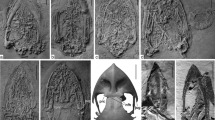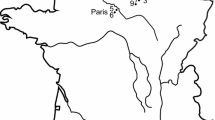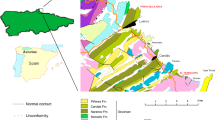Abstract
The Sandcoleidae are stem group representatives of the Coliiformes (mousebirds). These birds are among the most abundant medium-sized arboreal birds in some early and middle Eocene fossil sites of Europe and North America, and they are particularly well represented in the German locality Messel. Here, new sandcoleid fossils from Messel are reported. Most of these are tentatively assigned to Eoglaucidium pallas, which is the only named European sandcoleid species, but one specimen is likely to represent a new, unnamed species. Another fossil exhibits exceptionally well-preserved feather remains, which show that the tail of sandcoleids was not as greatly elongated and stiffened as that of extant mousebirds (Coliidae). It is hypothesised that these differences in the tail morphology of sandcoleids and coliids may have been due to changes in the habitual perching posture, which occurred early in the evolutionary history of the Coliidae.






Similar content being viewed by others
References
Baumel, J. J. & Witmer, L. M. (1993). Osteologia. In J. J. Baumel, A.S. King, J. E. Breazile, H. E. Evans, & J. C. Vanden Berge (Eds.) Handbook of avian anatomy: Nomina anatomica avium, 2nd edn. Publications of the Nuttall Ornithological Club, 23, 45–132.
de Juana, E. (2001). Family Coliidae (Mousebirds). In J. del Hoyo, A. Elliott, & J. Sargatal (Eds.) Handbook of the Birds of the World, vol. 6: Mousebirds to Hornbills (pp. 60–77). Barcelona: Lynx Edicions.
Feduccia, A., & Martin, L. D. (1976). The Eocene zygodactyl birds of North America (Aves: Piciformes). Smithsonian Contributions to Paleobiology, 27, 101–110.
Fischer, K. (1987). Eulenreste (Eoglaucidium pallas nov. gen., nov. sp., Strigiformes, Aves) aus der mitteleozänen Braunkohle des Geiseltals bei Halle (DDR). Mitteilungen aus dem Zoologischen Museum in Berlin, 63. Supplement: Annalen für Ornithologie, 11, 137–142.
Hackett, S. J., Kimball, R. T., Reddy, S., Bowie, R. C. K., Braun, E. L., Braun, M. J., Chojnowski, J. L., Cox, W. A., Han, K.-L., Harshman, J., Huddleston, C. J., Marks, B. D., Miglia, K. J., Moore, W. S., Sheldon, F. H., Steadman, D. W., Witt, C. C., & Yuri, T. (2008). A phylogenomic study of birds reveals their evolutionary history. Science, 320, 1763–1767.
Houde, P., & Olson, S. L. (1992). A radiation of coly-like birds from the early Eocene of North America (Aves: Sandcoleiformes new order). In K. E. Campbell (Ed.), Papers in Avian Paleontology honoring Pierce Brodkorb. Natural History Museum of Los Angeles County, Science Series (Vol. 36, pp. 137–160).
Jarvis, E. D., Mirarab, S., Aberer, A. J., Li, B., Houde, P., Li, C., Ho, S. Y. W., Faircloth, B. C., Nabholz, B., Howard, J. T., Suh, A., Weber, C. C., da Fonseca, R. R., Li, J., Zhang, F., Li, H., Zhou, L., Narula, N., Liu, L., Ganapathy, G., Boussau, B., Bayzid, M. S., Zavidovych, V., Subramanian, S., Gabaldón, T., Capella-Gutiérrez, S., Huerta-Cepas, J., Rekepalli, B., Munch, K., Schierup, M., et al. (2014). Whole-genome analyses resolve early branches in the tree of life of modern birds. Science, 346, 1320–1331.
Ksepka, D. T., & Clarke, J. A. (2009). Affinities of Palaeospiza bella and the phylogeny and biogeography of mousebirds (Coliiformes). The Auk, 126, 245–259.
Ksepka, D. T., & Clarke, J. A. (2010). New fossil mousebird (Aves: Coliiformes) with feather preservation provides insight into the ecological diversity of an Eocene North American avifauna. Zoological Journal of the Linnean Society, 160, 685–706.
Ksepka, D. T., Stidham, T. A. & Williamson, T. E. (2017). Early Paleocene landbird supports rapid phylogenetic and morphological diversification of crown birds after the K-Pg mass extinction. Proceedings of the National Academy of Sciences, 114, 8047–8052.
Levey, D. J. (1987). Seed size and fruit-handling techniques of avian frugivores. The American Naturalist, 129, 471–485.
Mayr, G. (2000). New or previously unrecorded avian taxa from the Middle Eocene of Messel (Hessen, Germany). Mitteilungen aus dem Museum für Naturkunde in Berlin, Geowissenschaftliche Reihe, 3, 207–219.
Mayr, G. (2001). New specimens of the Middle Eocene fossil mousebird Selmes absurdipes Peters 1999. Ibis, 143, 427–434.
Mayr, G. (2002). Avian remains from the Middle Eocene of the Geiseltal (Sachsen-Anhalt, Germany). In Z. Zhou & F. Zhang (Eds.), Proceedings of the 5th symposium of the Society of Avian Paleontology and Evolution, Beijing, 1–4 June 2000 (pp. 77–96). Beijing: Science Press.
Mayr, G. (2005). A new Eocene Chascacocolius-like mousebird (Aves: Coliiformes) with a remarkable gaping adaptation. Organisms Diversity & Evolution, 5, 167–171.
Mayr, G. (2006). New specimens of the Eocene Messelirrisoridae (Aves: Bucerotes), with comments on the preservation of uropygial gland waxes in fossil birds from Messel and the phylogenetic affinities of Bucerotes. Paläontologische Zeitschrift, 80, 390–405.
Mayr, G. (2009). Paleogene fossil birds. Heidelberg: Springer.
Mayr, G. (2011). Two-phase extinction of “Southern Hemispheric” birds in the Cenozoic of Europe and the origin of the Neotropic avifauna. Palaeobiodiversity and Palaeoenvironments, 91, 325–333.
Mayr, G. (2013). Late Oligocene mousebird converges on parrots in skull morphology. Ibis, 155, 384–396.
Mayr, G. (2014). Comparative morphology of the radial carpal bone of birds and the phylogenetic significance of character variation. Zoomorphology, 133, 425–434.
Mayr, G. (2015). A new specimen of the early Eocene Masillacolius brevidactylus and its implications for the evolution of feeding specializations in mousebirds (Coliiformes). Comptes Rendus Palevol, 14, 363–370.
Mayr, G. (2017a). Avian evolution: the fossil record of birds and its paleobiological significance. Chichester: Wiley-Blackwell.
Mayr, G. (2017b). The early Eocene birds of the Messel fossil site: a 48 million-year-old bird community adds a temporal perspective to the evolution of tropical avifaunas. Biological Reviews, 92, 1174–1188.
Mayr, G. (in press). Vögel – die artenreichste Wirbeltiergruppe in Messel. In S. F. K. Schaal, K. T. Smith, & J. Habersetzer, J. (Eds.) Messel: ein fossiles Tropenökosystem (pp. 170–215). Stuttgart: Schweizerbart.
Mayr, G., & Mourer-Chauviré, C. (2004). Unusual tarsometatarsus of a mousebird from the Paleogene of France and the relationships of Selmes Peters, 1999. Journal of Vertebrate Paleontology, 24, 366–372.
Mayr, G., & Peters, D. S. (1998). The mousebirds (Aves: Coliiformes) from the Middle Eocene of Grube Messel (Hessen, Germany). Senckenbergiana lethaea, 78, 179–197.
O’Reilly, S., Summons, R., Mayr, G. & Vinther, J. (2017). Preservation of uropygial gland lipids in a 48-million-year-old bird. Proceedings of the Royal Society B, 20171050.
Peters, D. S. (1999). Selmes absurdipes, new genus, new species, a sandcoleiform bird from the oil shale of Messel (Germany, Middle Eocene). In S. L. Olson (Ed.) Avian aleontology at the close of the 20th century: Proceedings of the 4th International Meeting of the Society of Avian Paleontology and Evolution, Washington, D.C., 4-7 June 1996. Smithsonian Contributions to Paleobiology, 89, 217–222.
Prum, R. O., Berv, J. S., Dornburg, A., Field, D. J., Townsend, J. P., Lemmon, E. M., & Lemmon, A. R. (2015). A comprehensive phylogeny of birds (Aves) using targeted next-generation DNA sequencing. Nature, 526, 569–573.
Stegmann, B. (1965). Funktionell bedingte Eigenheiten am Metacarpus des Vogelflügels. Journal of Ornithology, 106, 179–189.
Zelenkov, N. V., & Dyke, G. J. (2008). The fossil record and evolution of mousebirds (Aves: Coliiformes). Palaeontology, 51, 1403–1418.
Acknowledgements
I thank Stephan Schaal and Anika Vogel (both SMF) for the loan of fossil specimens. Carl Mehling (AMNH) enabled examination of Uintornis. Sven Tränkner (SMF) took the photographs of the bird fossils from Messel. Comments from Ursula Göhlich (Naturhistorisches Museum Wien) and an anonymous reviewer improved the manuscript.
Author information
Authors and Affiliations
Corresponding author
Ethics declarations
Conflict of interest
The author declares that he has no conflict of interest.
Rights and permissions
About this article
Cite this article
Mayr, G. New data on the anatomy and palaeobiology of sandcoleid mousebirds (Aves, Coliiformes) from the early Eocene of Messel. Palaeobio Palaeoenv 98, 639–651 (2018). https://doi.org/10.1007/s12549-018-0328-1
Received:
Revised:
Accepted:
Published:
Issue Date:
DOI: https://doi.org/10.1007/s12549-018-0328-1




